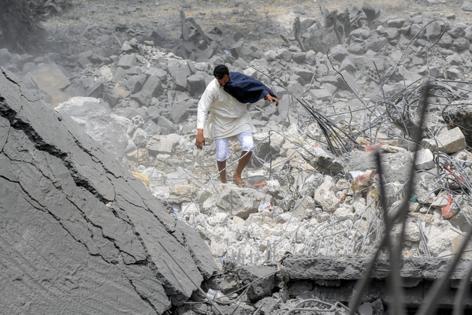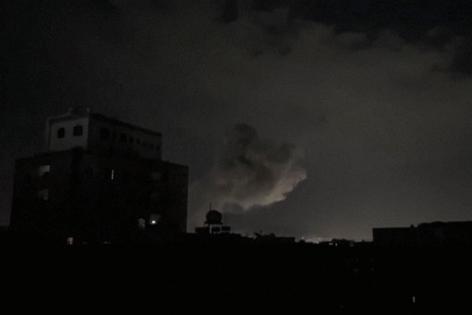US progress against resilient Houthi militants remains murky
Published in News & Features
President Donald Trump has boasted that he’s “decimated” the Houthis, the Iran-backed militants who have attacked commercial ships transiting the Red Sea since 2023. But three weeks into a campaign of U.S. airstrikes, his administration has offered limited evidence of weapons deployed and targets hit to back up that assertion.
Former President Joe Biden’s administration provided frequent updates on its hundreds of operations against the Houthis, through Pentagon briefings and shared satellite images showing the results of strikes. Officials met with members of Congress before and after operations.
Much of what’s known about the recent U.S. attacks under Trump came by accident, from a Signal chat spelling out details of an impending assault that unintentionally included an editor from The Atlantic magazine.
The secrecy about Yemen is raising skepticism among foreign policy and national security experts that Trump’s strategy — which he’s touted as “powerful and decisive” — can restore freedom of navigation on one of the world’s most important shipping routes. Major shipping lines continue to rely on a longer, and costlier, but safer route around the southern tip of Africa.
There’s little doubt that the recent U.S. airstrikes have been intensive — more than $200 million in munitions have been used so far, according to the New York Times — but the Houthis have proved resilient through years of attacks.
Efforts by Saudi Arabia, the United Arab Emirates and the U.S. for most of a decade failed to defeat the militants. The group has seized control of northern Yemen, holding its capital Sanaa since 2014 as well as the key Red Sea port of Hodeida.
The recent airstrikes on the Houthis come as Trump is threatening to bomb Iran unless it engages in direct negotiations with the U.S. and then signs a deal renouncing nuclear weapons. Iran has said it will participate in indirect talks and maintains its nuclear program is solely for peaceful purposes.
Trump backed up his threat by ordering that two aircraft carrier strike groups, rather than the usual one, be deployed to the Middle East to pressure Iran and protect U.S. interests.
The Houthis’ operations, including the drones on which they rely, are easy to move from one place to another, making them difficult to target from the air, said Jonathan Panikoff of the Atlantic Council’s Middle East Program.
“The question that I’ve been asking, and others have been asking, is, ‘Why does the Trump administration expect this bombing of the Houthis to have any more effect than seven years of pretty extreme Saudi and Emirati bombings, including a ground invasion?’” said Annelle Sheline, a research fellow at the Quincy Institute for Responsible Statecraft who spent a year serving in the State Department during the Biden administration.
In response to questions from Bloomberg News, a U.S. defense official said that Central Command is carrying out strikes across multiple Houthi locations every day and night. The official said the U.S. has confirmed the death of several Houthi leaders and destroyed command and control facilities, air defense systems, weapons manufacturing facilities and advanced weapons storage locations. The official spoke on condition of anonymity and declined to share specific military tactics and targets, citing operational security.
“The United States continues to unleash the arsenal of America against Houthi terrorists who have for too long terrorized international shipping and attacked US Navy vessels. President Trump is committed to restoring freedom of navigation through the Red Sea,” National Security Council spokesman James Hewitt said in an emailed statement on Saturday.
But Trump posted an aerial video on X Friday night showing an oval formation of people followed by a huge explosion. “These Houthis gathered for instructions on an attack,” he wrote. “Oops, there will be no attack by these Houthis!”
More than 60 civilians have been killed in the strikes since mid-March, according to the Houthi-run health ministry based in Sanaa. The Houthis have acknowledged that at least 40 of their fighters have been killed, including some with the rank of colonel. The Houthis’ leader, Abdul Malik Al-Houthi, is still at large.
Trump promised before taking office to end “forever wars” like the past conflicts in Iraq and Afghanistan. But the Pentagon has so far offered no public blueprint for completing the mission in Yemen. Defense Department spokesman Sean Parnell has said that the U.S. plans to “use overwhelming lethal force until we have achieved our objective” but cautioned that “this is also not an endless offensive.”
Secretary of State Marco Rubio told reporters at a foreign ministers meeting in Brussels that “the world should be grateful to the United States for being involved in this and doing this” because “nobody else can project power there and do this.”
National security adviser Mike Waltz has contrasted the overwhelming force of recent U.S. attacks with what he depicted as hundreds of slow and measured “pinprick” attacks under Biden that he derided as “feckless.” But the reliance on airstrikes shows that Trump is following the same core path as Biden, said Frederic Wehrey, a senior fellow in the Middle East Program at the Carnegie Endowment for International Peace and veteran Air Force officer.
“This is an administration that came to office promising an end to the forever wars,” Wehrey said. “Now you have the administration going down the very same path as the Biden administration.”
The lack of details about the current operations in Yemen has attracted attention in Congress.
Sens. Jeff Merkley, an Oregon Democrat, and Rand Paul, a Kentucky Republican, wrote to Trump asking him to explain his plan to deal with the Houthis. The senators said the president failed in his responsibility to consult with Congress before the Yemen operation, as required under the long-disputed War Powers Act, and they raised concerns about the potential of war with Iran.
The Trump administration is “not sharing a lot of information in the sense of even after-action reports,” said Ben Friedman, policy director of Defense Priorities, a Washington think tank that’s skeptical about the use of force. “The administration is conflating violence with success. They’re talking about bombing buildings, collapsing buildings, as if that were a victory. The tactical effect is not particularly meaningful.”
Rather than taking out Houthi operations, the U.S. intention may be to pressure Iran to lessen its support for the group and to curb Tehran’s nuclear program, Carnegie’s Wehrey said.
“They’re reminding Iran that they can still hit their proxies,” Wehrey said.
———
(With assistance from Mohammed Hatem and Nick Wadhams.)
©2025 Bloomberg L.P. Visit bloomberg.com. Distributed by Tribune Content Agency, LLC.










Comments